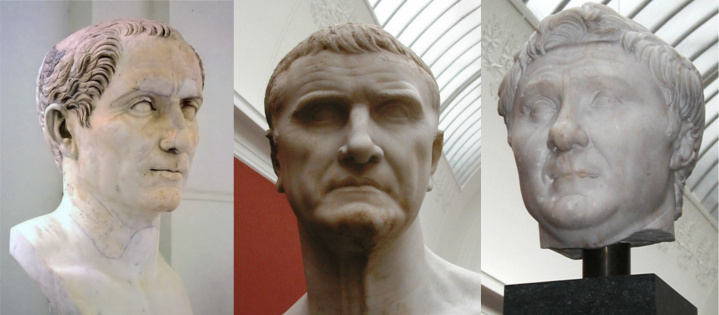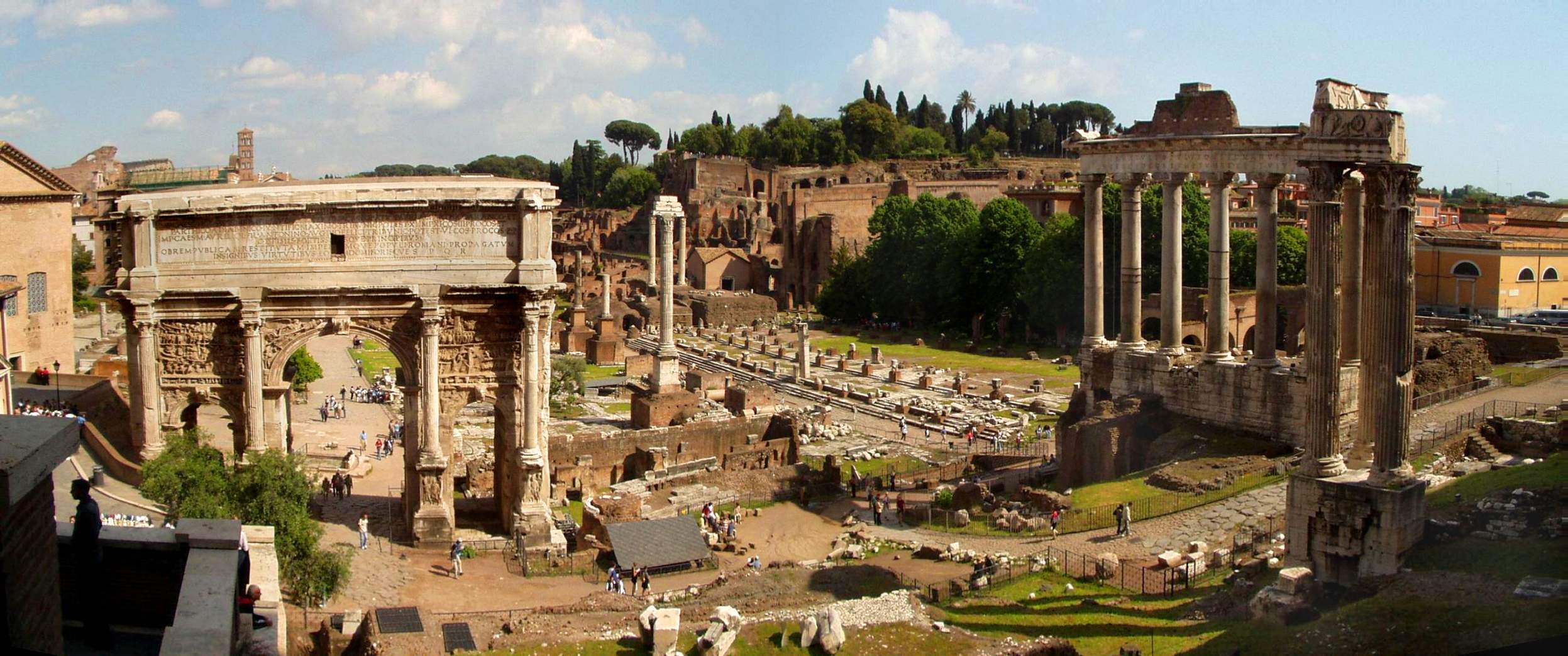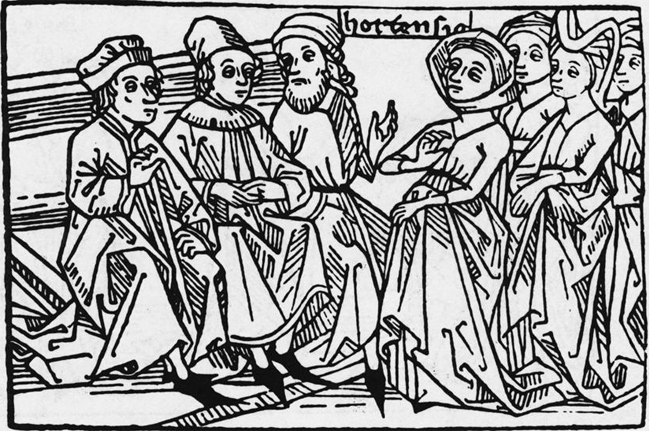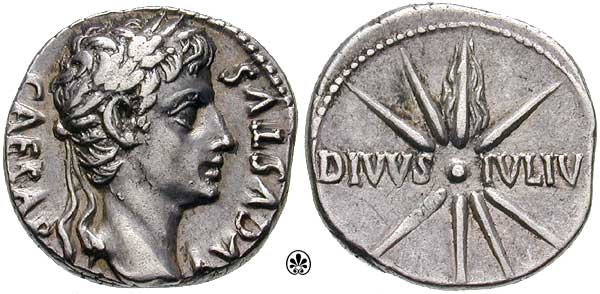 Focus Question: How did the government of the Roman Republic contribute to the development of modern-day democracy?
Focus Question: How did the government of the Roman Republic contribute to the development of modern-day democracy?
The Roman Republic lasted from 509 to 27 BCE

Topics on the Page
Government of the Roman Republic
- Roman Rule of Law
- Julius Caesar
- Spartacus and Slave Revolts
Democratic Principles and Practices
Women Roles
- Hortensia
- Roman Marriage and Divorce
Influences on the American System
 Special Topic Page: The American Political System
Special Topic Page: The American Political System
 Cross-Links
Cross-Links

Polybius's view on how the Roman Republic defies the ancient cycles of history
- attributed to a mixed government that incorporates checks and balances (i.e. senate and consul)
- explains how different forms of government degrade into more evil forms in a cyclical pattern
View the Loeb Classical Library from Harvard University Press and the Perseus Collection from Tufts University to read and compare original documents written by Roman authors.
- Much of the historiography on the Roman Republic is not primary evidence, but was written by later historians living in the Roman Empire.
- However, these documents can be analyzed to give an understanding of the biased (and often contradictory) narratives that ancient Romans had of their own history.
Quick overview of Republican Rome
Government of the Roman Republic
Chart from Ancient History Sourcebook

Roman Government Setup
This diagram shows the ladder of political advancement (cursus honorum) during the late Republic.
- The straight ladder shows the typical path of advancement (theoretically open to all freeborn male citizens), beginning with election to quaestor, the lowest office, and proceeding to consul, the highest.
- Of course very few men made it that far; it was quite exceptional when a man like Cicero, who did not come from a noble family, was elected consul).
Red text designates “curule magistrates,” who had the right to sit on a special ivory folding stool (sella curulis) as a symbol of their office; they also had the right to wear the purple-bordered toga (toga praetexta).
- Offices marked with an asterisk carried imperium, the highest political authority, which included the right to command an army, to interpret and carry out the law, and to pass sentences of death.
- Magistrates whose title began with “pro” were in charge of provinces; the Senate normally conferred these after the men had finished their term of office in Rome.
- The more important provinces, especially those requiring large military forces, were assigned to ex-consuls, while the less significant provinces were governed by ex-praetors. Most of these offices remained in place throughout the empire, though their functions changed.
After two Civil Wars, the term imperium was now reserved for the emperor, and advancement in rank proceeded in orderly stages based on conditions laid down by the emperors rather than through competitive electioneering.
- Thus the cursus honorum changed from a ladder of power (with important social status attached) to a ladder of primarily social rank and status.
- The cursus honors was reserved for men.
View artifacts and essays related to Roman portraits of elite individuals, and what these objects tell us about developments in Roman politics.
Resources for teachers
This website has access to quizzes and worksheets that students can use to learn about the Roman Government.
Death of Spartacus, Hermann Vogel (1881)

Spartacus and Slave Revolts
Brief Biography from BBC
 Spartacus War: Story of a Real-Life Gladiator, NPR Podcast (February 2, 2010)
Spartacus War: Story of a Real-Life Gladiator, NPR Podcast (February 2, 2010)
Read about (the real) Spartacus and the Slave Wars, which were some of the most significant popular revolts to occur under the Roman Republic.
- View a short essay exploring the extent to which race played a role in the Roman slave system.
CROSS-LINK: Toussaint L'Ouverture and the Haitian Revolution
- Toussaint L'Ouverture has been called the Black Spartacus
Roman collared slaves — Marble relief

Slaves, the Labor Force, and the Economy, Roman Empire in the First Century
Roman Slavery, World History For Us All, UCLA

Citizenship in the Roman Republic, Los Angeles Unified School District
Roman Republic, Stanford History Education Group
Republic to Empire: Government in Ancient Rome, National Geographic

- The First Triumvirate: “The First Triumvirate, consisting of Julius Caesar, Crassus, and Pompey, came to power in 59 BC when Caesar was elected consul.
- Monarchy: As the Roman empire moved to a monarchy the people still had their freedoms but there would be one person who ruled and decided what was best for everyone.
- Until Augustus the religion and state were separate but in a different way than what we think of today. When Julius Caesar died he was made a Roman “god”.
 The following video explores (quite comically) the structure of the Roman Government and the definition of Republic and Empire.
The following video explores (quite comically) the structure of the Roman Government and the definition of Republic and Empire.
 Julius Caesar Biography
Julius Caesar Biography
Roman Rule of Law
Learn about how law and its processes were codified during the Roman Republic, and the role of the Plebeian class in this development.
.png) The Laws of the 12 Tables
The Laws of the 12 Tables
- The first written laws in Rome were known as the 12 Tables
- These set some strict laws for Roman citizens
- Both Patricians and Plebeains had to abide by these rules
- They covered topics from marriage to economic and business issues
.png) See this essay from Ohio State University about how Western systems of law inherently prioritize marital relationships over parental ones, to the disadvantage of women. The author traces this tradition back to the first marriage law in ancient Rome (see page 1529).
See this essay from Ohio State University about how Western systems of law inherently prioritize marital relationships over parental ones, to the disadvantage of women. The author traces this tradition back to the first marriage law in ancient Rome (see page 1529).
Fall of the Roman Republic
With the fall of the Roman Republic began the dawn of the Roman Empire. After Julius Ceasar was assassinated, his nephew Octavian (Augustus) along with his ally, Marc Antony, fought for and won control of Rome. Octavian gave Egypt to Antony and took Rome for himself. To read a more detailed description on how Rome went from a Republic to an Empire, click here.
Link here for "The Fall of the Roman Republic," an account by historian Mary Beard of the transformation from republic to empire from the British Broadcasting Company.
Democratic Principles and Practices
.png) The Constitution of the Mid-Republic from Polybius, The Histories
The Constitution of the Mid-Republic from Polybius, The Histories
In addition to the table below this video explains the roles of the Republican offices well.
- See more about the role of Senators in the Roman Republic, and later under the Roman Empire.
Separation of powers: Within the system of government, the Roman republic had its own system of checks and balances. The Roman model attempted to balance the three forces that clashed in Roman society: representation and participation of the poor; the power and influence of the elite; and the need to enact swift decision making outside of representative government.
Monarchical
|
Aristocratic
|
Democratic
|
2 Consuls
+ other magistrates
|
Senate
|
Assembly of Tribes (plebeians)
Tribune
|
- Directed government and army
- Acted as judges
- Could issue edicts
- Acted as chief priest
|
- Controlled state budget
- Could pass laws
- Approx. 330 members
- Could appoint a dictator (in emergency)
|
- Approved/rejected laws by direct vote
- Decided on war
- Tribune could veto actions of magistrate
- Acted as final court
|
Basis of power:
- Possess imperium, the right to rule
- Need for leadership
|
Basis of power:
- Members were richest men in Rome
|
Basis of power:
- Provided most of the soldiers
|
Limits on power:
- One year term
- Each could veto the other
|
Limits on power:
- Could not control army
- Needed majority as soldiers
|
Limits on power:
- Could not suggest laws
- Often paid as clients by the elite (Senate)
|
The balance the Romans sought with this system of government worked well. But you have to keep in mind that the Romans did not aim to make there government a fair one. (Click here for a better look at the government structure)
- Early in the Republic the ruling class were the Patricians and only them
- Plebeians were only granted a right to an Assembly after much conflict with this class
- Even then they were granted limited rights and had to fight for each right listed above. They did not have all of these rights to start of with.
- And due to the wealth of the Patricians (senators) the Assembly of the Tribes and the Assembly of People (Plebeian government) were often paid off so votes went the senates way and sympathetic Tribunes would be elected.
Comparison to the American political system structure
Legislative
|
Judicial
|
Executive
|
Congress
|
Supreme Court
|
President
|
The Roman Forum Image by Hans E C Johansson

Image to the right shows the Roman Forum which was the center of the public sphere in Rome. Much of Rome's political process took place here.
For an interactive guide to the Roman Forum, click on the image.
- Rome was a mixed government like the US. Rome had dictatorial (Dictator/Consul), Oligarchical (Senate) and Democratic/Republican (Plebeain assemblies/voting) aspects to they government.
- The US does have similar powers. The president controls the military but the Senate runs the budget.
 Representative government structure: the government of the Roman Republic was first a republic and representative form of government until the republic collapsed after a series of violent civil wars.
Representative government structure: the government of the Roman Republic was first a republic and representative form of government until the republic collapsed after a series of violent civil wars.
- This was a very limited representative government, only wealthy members of the Senate could vote.
- The US limited its on voters initially but came to have universal suffrage.
- Civic duties: People felt it was their civic duty to vote ( men at least, since women couldn't vote or hold any power). They felt it was an honor and duty to serve in the Roman army.
- The US also has a sense of civic duty, We have a standing all volunteer army and a vast bureaucracy that makes the system run, all staffed by civic minded citizens
One thing that needs to be said about comparing the US to Rome is that Republican and Democratic Ideals have evolved. Rome had similar traits as our democracy but Republican Rome was basically run by the Senate, making it more of an Oligarchy (rule of the few over the many). This was true until the first century BCE when successive strong men eroded the power and influence of the senate, leading to almost a century of civil wars and culminating in the creating of the Roman Empire under Augustus.
Today the US has much broader representation and voter rights, making for a stronger republic and democracy.
Women's Roles
Overview of women in Rome
- During the entire period of Roman history women were prohibited from holding political office, though in the empire their roles as mothers, wives, and daughters of emperors gave a few women very high social status and even a kind of indirect rank.
- Even elite women who were not members of the imperial family sometimes claimed the rank of their fathers or husbands (e.g., as consulares feminae, “consular women”).
- For further information on women in the Roman Empire, click here.
Roman Orator Hortensia

Although women were excluded from the political process in Rome, this did not stop them from attempting to exert influence.
- In 42 BCE the Roman Senate proposed to levy a tax on wealthy women to help fund the military.
- The women and their families protested.
- Specifically Hortensia
Hortensia
- Daughter of a famous orator
- Spoke out in the Roman Forum against taxation without representation.
- She was the first woman known to ever give a public speech in the Forum.
- Succeed in only partially reducing the tax. Instead of taxing the 1400 most wealthy Roman women the number was reduced to 400.
- Octavian, Marc Anthony and Lepidus were force to make up the difference with another tax on male land owners.
Fulvia
• Though woman did not have direct power in government, certain woman such as Fulvia were able to influence the men who were in power.
Hortensia's Speech
Click here for a lesson plan about the incident, which includes an excerpt of Hortensia's speech.
For another perspective on women's roles, see Female Gladiators. See also Marble Relief from the British Museum.
Insight into the life of a teenager in Rome
- apartments vulnerable to fires
- half the children from ancient Rome die before they reach adulthood
- education almost complete at age 17 (learn how to read and write in Greek and Latin)
- talk how to fight in battle
- arranged marriages
Roman marriage and divorce
- Marriage laws
- simple ceremonies
- age difference between bride and groom
- simple process of divorce
Roman Influences on the American System
The United States Constitution is modeled after the Roman system of separation of powers and the idea of representative government.
For more, see Special Topic Page on American Political System Overview
The Roman system was based on a balance of interest. The American Founding Fathers were heavily influenced by the Romans but the United States' system of checks and balances is based on a balance of powers and functions.
- The Founding Fathers built off what the Romans created: kept term limits, didn't vest power in one branch or person ( Romans did this but only in times of crisis and only for 6 month terms)
- They created a more formalized system of checks and balances: Three branches with set powers that are some what equal or can be used to stop another branch from gaining more power.
- For all intensive purposes the Senate ruled Rome, they elected the senators from they're own Patrician class, they elected consuls, dictators, praetors from the senate, and they kept the Plebeians down with limiting their rights and chance of advancing up the social ladder.
- The Founders also expanded voting rights: Republican Rome started out with only allowing wealthy people of the Senate to vote, Patricians. This class was initially established from families that could trace their lineage to founding families of Rome.
- The Founders did create this country so only white, male, land owners could vote. But unlike Rome they built a framework , The Constitution, that allowed the government to change, eventually allowing everyone over 18 to vote.
- For an interesting look at how the Romans influenced the contemporary world, watch this BBC documentary, here
- The United States did not just inherit Republican ideas from the Romans.
- View a lecture discussing the ancient Roman slave system and how it influenced the structure and ideology of slavery in the United States.
.png) Learning plan: Compare and contrast Roman and American coins.
Learning plan: Compare and contrast Roman and American coins.
- Have students look at the images and text presented on each coin, and compare and contrast all of the elements.
- Have them consider the relation between the coins and the governments they were issued under.
- Ask them why each regime would want to broadcast these various images and words, and why they chose to broadcast them on coins.
Ancient Roman coin with image of Marcus Junius Brutus Denarius on obverse, ca. 54 BCE.

Ancient Roman coin with image of Augustus Caesar, the first Roman Emperor, on obverse and "Divus Julius" written on reverse, issued sometime after the fall of the Roman Republic.

Contemporary American penny, 2002.

Contemporary American quarter. This design first introduced in 1932.
END NOTES
[1] The Charters of Freedom, "Transcript of the Constitution of the United States." Accessed February 6, 2012. http://www.archives.gov/exhibits/charters/constitution_transcript.html. [2] "US Government Branches ." Accessed February 14, 2007. http://www.ac-orleans-tours.fr/hist-geo3/sec-euro/Sec-Euro-2nde/american-revolution/federal3.htm. [3] Conflict and Community in the Corinthian Church, "Map of the Roman Empire." Accessed February 6, 2012. http://gbgm-umc.org/umw/corinthians/empire.stm. [4] The 2012 State of the Union: An America Built to Last, "Executive Branch, Legislative Branch, Judicial Branch." Accessed February 6, 2012. http://www.diigo.com/bookmark/http://www.whitehouse.gov/our-government/executive-branch?tab=comment.
New images obtained from Wikimedia Commons 14 June 2011
Comments (0)
You don't have permission to comment on this page.